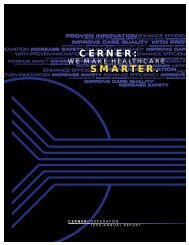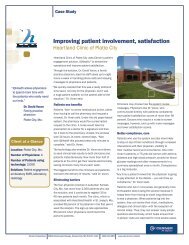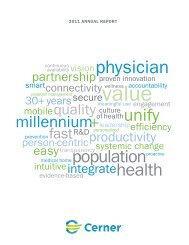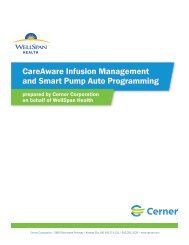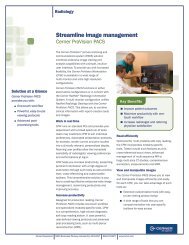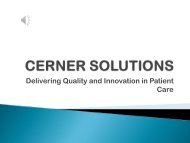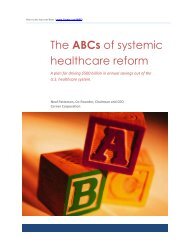The ABCs of systemic healthcare reform - Cerner Corporation
The ABCs of systemic healthcare reform - Cerner Corporation
The ABCs of systemic healthcare reform - Cerner Corporation
- No tags were found...
You also want an ePaper? Increase the reach of your titles
YUMPU automatically turns print PDFs into web optimized ePapers that Google loves.
most <strong>of</strong> our <strong>healthcare</strong> spending relates to chronic conditions, there is a desperate need for incentives to keep people healthy and<br />
out <strong>of</strong> doctors’ <strong>of</strong>fices and hospitals. We pay for sick care today; in the future, we must add the concept <strong>of</strong> health care.<br />
Healthcare <strong>reform</strong> has been attempted in every American generation in the past century, by presidents Roosevelt (both <strong>of</strong> them),<br />
Truman, Nixon and Clinton. In 2009, we arrive at this point again, this time with a convergence <strong>of</strong> events, some extra incentive to<br />
get it right. We do believe we can, by leveraging this IT investment, create a <strong>systemic</strong> change in <strong>healthcare</strong>, and that change can<br />
drive $500 billion out <strong>of</strong> the annual cost <strong>of</strong> <strong>healthcare</strong>. Rather than baby boomers like me “busting” the system, we can leave<br />
behind a modern, affordable, frictionless, high-quality <strong>healthcare</strong> system for generations to come.<br />
A great deal needs to be decided in the next two years. Personally, I believe the <strong>ABCs</strong> are a narrative <strong>of</strong> the right direction; the<br />
challenge with each step is that we need to articulate the benefits to us as individuals, to physicians, hospitals, <strong>healthcare</strong> delivery<br />
systems, government, employers, insurance companies—to all who will be involved. <strong>The</strong>re are a lot <strong>of</strong> stakeholders. What we need<br />
now is a vision for how the new <strong>healthcare</strong> system serves us as individuals, as families and as communities.<br />
Now is the right time to talk about what we want for future generations. I have presented my version.<br />
<strong>Cerner</strong> and the Next Decade—Our 2020 Vision<br />
For the better part <strong>of</strong> three decades, <strong>Cerner</strong> has grown organically by articulating a vision <strong>of</strong> a future state for <strong>healthcare</strong><br />
organizations and society. As we finish 2009, three major milestones will have been achieved. <strong>The</strong> first milestone will come<br />
as we finish our first decade <strong>of</strong> the 21 st century and arrive at the threshold <strong>of</strong> the second. While this is just a passing <strong>of</strong> time,<br />
let’s not forget Y2K was a mere 10 years ago. Back then, there was a fear that computers would cease to function as the clock<br />
turned to this new millennium. Now 10 years later, in our 2008 Annual Report, we are describing how and when all <strong>of</strong> the U.S.<br />
<strong>healthcare</strong> system will be completely digitized. <strong>The</strong> first decade has been hard but very good to <strong>Cerner</strong> and its associates, clients<br />
and shareholders. <strong>The</strong> next one will change the face <strong>of</strong> the HIT and the <strong>healthcare</strong> industry.<br />
<strong>The</strong> second milestone will be the 30-year anniversary <strong>of</strong> the moment when Paul, Cliff and I sat together at a picnic table in Kansas<br />
City’s Loose Park, dreaming and planning what type <strong>of</strong> company to start. We have lived the American Dream. Along the way, we<br />
have also created a lot <strong>of</strong> jobs—careers for our associates—almost 8,000 high quality, new and ongoing jobs. Today, we are the<br />
largest non-governmental employer on the western side <strong>of</strong> Missouri. In the next decade, we expect to see a continuation <strong>of</strong> rapid<br />
growth <strong>of</strong> jobs inside <strong>Cerner</strong>. Finally, the third milestone is that the end <strong>of</strong> the Electronic Medical Record era in the United States<br />
is now in plain sight. By law, we should have a digital <strong>healthcare</strong> system at some point in the next decade.<br />
This should create the basic question, what is next? If you care to, go back and read the past five to 10 annual reports. We have<br />
already answered this question, and we believe <strong>Cerner</strong> is as well or better prepared for the next era as any company in <strong>healthcare</strong>.<br />
Here is a quick review <strong>of</strong> why we are excited about the coming era.<br />
In 2006 in this letter, we introduced the five-box model that is<br />
still our blueprint for this next decade. By way <strong>of</strong> refresher, the<br />
center box is the U.S. <strong>healthcare</strong> market, a $2.3 trillion market<br />
with healthy compound annual growth rates that will cause it to<br />
double by 2019. <strong>The</strong> second box represents the global markets<br />
for digitizing <strong>healthcare</strong> delivery, where we have clients in more<br />
than 25 countries on six continents. <strong>The</strong> third box represents<br />
the medical device industry, which will increasingly become a<br />
part <strong>of</strong> the HIT industry. <strong>The</strong> fourth box is the Pharma industry,<br />
where the transparency created by a digital <strong>healthcare</strong> system will<br />
fundamentally change the discovery <strong>of</strong> new knowledge, the ways<br />
to design and conduct clinical trials and surveillance systems for<br />
medicines in active use. Finally, a fifth box holds the opportunity<br />
to completely redesign the fundamental commerce <strong>of</strong> <strong>healthcare</strong>,<br />
eliminating the friction that consumes more than 30% <strong>of</strong> precious<br />
resources, connecting governments, employers and consumers<br />
directly with their <strong>healthcare</strong> pr<strong>of</strong>essionals, facilitating the whole<br />
process based on personalized needs <strong>of</strong> the individual.<br />
12



